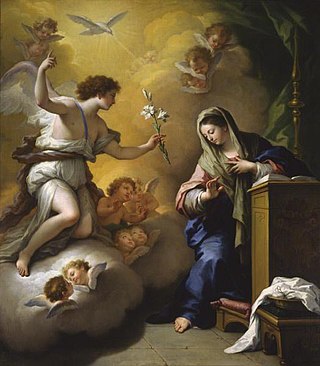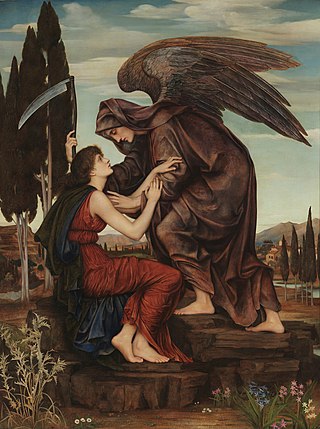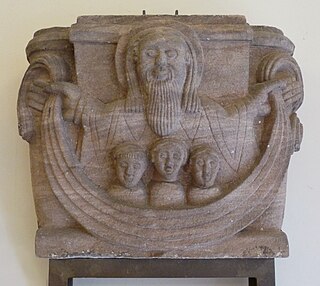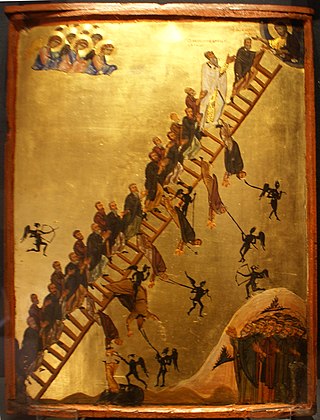Related Research Articles

Archangels are the second-lowest rank of angel in the Christian hierarchy of angels, put forward by Pseudo-Dionysius the Areopagite in the 5th or 6th century in his book De Coelesti Hierarchia. The word "archangel" itself is usually associated with the Abrahamic religions, but beings that are very similar to archangels are found in a number of other religious traditions.

Metatron, or Matatron, is an angel in Judaism, Christianity, and Islam mentioned three times in the Talmud, in a few brief passages in the Aggadah, and in mystical Kabbalistic texts within Rabbinic literature. The figure forms one of the traces for the presence of dualist proclivities in the otherwise monotheistic visions of both the Tanakh and later Christian doctrine. In the Jewish kabbalistic tradition, he is sometimes portrayed as serving as the celestial scribe. The name Metatron is not mentioned in the Torah or the Bible, and how the name originated is a matter of debate. In Islamic tradition, he is also known as Mīṭaṭrūn, the angel of the veil.

Samael is an archangel in Talmudic and post-Talmudic lore; a figure who is the accuser or adversary, seducer, and Destroying angel.

Azrael is the angel of death in some Abrahamic religions, namely Islam and Christian popular culture.

Fallen angels are angels who were expelled from Heaven. The literal term "fallen angel" does not appear in any Abrahamic religious texts, but is used to describe angels cast out of heaven or angels who sinned. Such angels often tempt humans to sin.

Apocalyptic literature is a genre of prophetical writing that developed in post-Exilic Jewish culture and was popular among millennialist early Christians. Apocalypse is a Greek word meaning "revelation", "an unveiling or unfolding of things not previously known and which could not be known apart from the unveiling".
The Life of Adam and Eve, also known in its Greek version as the Apocalypse of Moses, is a Jewish apocryphal group of writings. It recounts the lives of Adam and Eve from after their expulsion from the Garden of Eden to their deaths. It provides more detail about the Fall of Man, including Eve's version of the story. Satan explains that he rebelled when God commanded him to bow down to Adam. After Adam dies, he and all his descendants are promised a resurrection.

The Israʾ and Miʿraj are the two parts of a Night Journey that Muslims believe the Islamic prophet Muhammad took during a single night around the year AD 621. Within Islam, "the majority" of scholars agree that the journey was both a physical and spiritual one. A brief mention of the story is found in the 17th surah (chapter) of the Quran, called al-Isra', while details of the story are found in the hadith.

In the Book of Ezekiel in the Hebrew Bible, New Jerusalem is Ezekiel's prophetic vision of a city centered on the rebuilt Holy Temple, the Third Temple, to be established in Jerusalem, which would be the capital of the Messianic Kingdom, the meeting place of the twelve tribes of Israel, during the Messianic era. The prophecy is recorded by Ezekiel as having been received on Yom Kippur of the year 3372 of the Hebrew calendar.
The Book of Moses, dictated by Joseph Smith, is part of the scriptural canon for some denominations in the Latter Day Saint movement. The book begins with the "Visions of Moses", a prologue to the story of the creation and the fall of man, and continues with material corresponding to the Joseph Smith Translation of the Bible's (JST) first six chapters of the Book of Genesis, interrupted by two chapters of "extracts from the prophecy of Enoch".

A Watcher is a type of biblical angel. The word occurs in both plural and singular forms in the Book of Daniel, where reference is made to the holiness of the beings. The apocryphal Books of Enoch refer to both good and bad Watchers, with a primary focus on the rebellious ones.

"Bosom of Abraham" refers to the place of comfort in the biblical Sheol where the righteous dead await Judgment Day.

The Apocalypse of Paul is a fourth-century non-canonical apocalypse and part of the New Testament apocrypha. The full original Greek version of the Apocalypse is lost, although fragmentary versions still exist. Using later versions and translations, the text has been reconstructed, notably from Latin and Syriac translations.
The Second Book of Enoch is a pseudepigraphic text in the apocalyptic genre. It describes the ascent of the patriarch Enoch, ancestor of Noah, through ten heavens of an Earth-centered cosmos. The Slavonic edition and translation of 2 Enoch is of Christian origin in the 8th century but is based on an earlier work. 2 Enoch is distinct from the Book of Enoch, known as 1 Enoch, and there is also an unrelated 3 Enoch, although none of the three books are considered canonical scripture by the majority of Jewish or Christian bodies. The numbering of these texts has been applied by scholars to distinguish each from the others.

Adam is a mythological being conceptualized as the first human-being aware of God, and features as such in various belief systems. He serves as a pattern of his descendants, influenced by everything he went through in associated stories, similar to how children are expected to resemble their parents. Unlike other religions featuring Adam, Christianity derived the concept of original sin from that idea.
2 Baruch is a Jewish pseudepigraphical text thought to have been written in the late 1st century CE or early 2nd century CE, after the destruction of the Temple in CE 70. It is attributed to the biblical figure Baruch ben Neriah and so is associated with the Old Testament, but not regarded as scripture by Jews or by most Christian groups. It is included in some editions of the Peshitta, and is part of the Bible in the Syriac Orthodox tradition. It has 87 sections (chapters).
In religious or mythological cosmology, the seven heavens refer to seven levels or divisions of the Heavens. The concept, also found in the ancient Mesopotamian religions, can be found in Judaism and Islam; the Christian Bible does not mention seven levels of heaven, it mentions three; a similar concept is also found in some other religions such as Hinduism. Some of these traditions, including Jainism, also have a concept of seven earths or seven underworlds both with the metaphysical realms of deities and with observed celestial bodies such as the classical planets and fixed stars.
Shamayim is the dwelling place of God and other heavenly beings according to the Bible. It is one of three components of the biblical cosmology. There are two other ones. Eretz (Earth), home of the living, and sheol, the realm of the dead—including, according to post Hebrew-Bible literature, the abode of the righteous dead.

In Christianity, heaven is traditionally the location of the throne of God and the angels of God, and in most forms of Christianity it is the abode of the righteous dead in the afterlife. In some Christian denominations it is understood as a temporary stage before the resurrection of the dead and the saints' return to the New Earth.

2 Corinthians 12 is the twelfth chapter of the Second Epistle to the Corinthians in the New Testament of the Christian Bible. It is authored by Paul the Apostle and Timothy in Macedonia in 55–56 CE.
References
- 1 2 Henry, Matthew,Archived 2006-08-25 at the Wayback Machine , Public domain, Library of Congress call no: BS490.H4, at Christian Classics Ethereal Library
- 1 2 3 Ginzberg, Louis (1909) The Legends of the Jews, Chapter 1, at sacred-texts.com
- ↑ See a good Commentary on Youtube (Ruckman, Andrew Gen. 1 part 1)
- ↑ van der Toorn, Becking, van der Horst (1999), Dictionary of Deities and Demons in The Bible, Second Extensively Revised Edition, Entry: Heaven, pp. 388–390, William B. Eerdmans Publishing Company, ISBN 0-8028-2491-9
- ↑ Baruch, Apocalypse of at jewishencyclopedia.com
- ↑ 2 Corinthians 12:2–4
- ↑ E. W. Bullinger A Critical Lexicon and Concordance to the English and Greek "2, 14, To this "Third heaven" and " Paradise " Paul was caught away, 2 Cor. xii. 2, 4, (not " up," see under " catch,") in "visions and revelations of the Lord," 2 Cor. xii. 1. One catching away – with a double revelation of the New heaven and the ..."
- ↑ Got Questions Ministries, "What does it mean that Paul went to the third heaven?" https://www.gotquestions.org/Paul-third-heaven.html
- 1 2 Davidson, Gustav (1967), A Dictionary of Angels, Including The Fallen Angels , Entry: Third Heaven, Free Press, p. 288, Library of Congress Catalog Card Number: 66-19757, ISBN 9780029070505
- ↑ "Celestial Glory". ChurchofJesusChrist.org. Retrieved 2019-01-19.
- ↑ Mi'raj at the Canadian Society of Muslims Website
- ↑ Al-Burhan fi Tafsir al-Qur'an. V. 5. p. 415.
{{cite book}}: CS1 maint: location (link) - ↑ Anton M. Heinen Islamic Cosmology 1982 Beirut Franz Steiner Verlag Wiesbaden isbn 3515-03177-4 p. 86